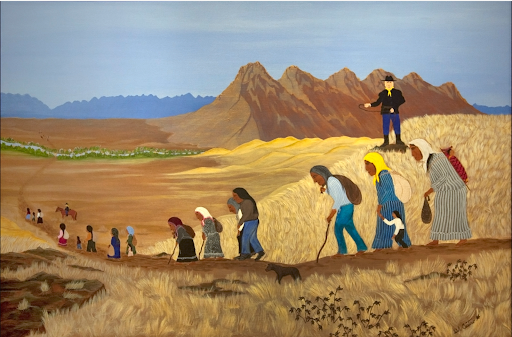Overview
Dal Castro, Maidu Walk

Authors and Collaborators:
- Cheryl Tuttle (Yurok/Karuk) Educator and Cultural Preservationist
- Editor/Format by Maggie Peters (Yurok/Karuk) NASMC Learning Specialists Humboldt County Office of Education
Grades: 3-5
Suggested Amount of Time: 60 minutes
Curriculum Themes:
- Cultural Strengths
- Relationship to Place
- Cross Curricular Integration
Learning Goals
- Understand the forced removal of the Konkow Maidu and Atsugewi peoples to the Round Valley Reservation in 1862 and the hardships they faced during this journey.
- Recognize the impact of U.S. government policies on Native communities and the resilience of Indigenous peoples during times of injustice.
- Analyze history from the perspective of Native people, understanding their experiences, struggles, and connections to their land.
- Appreciate how Native artists use their work to preserve memory, share cultural perspectives, and raise awareness about history.
- Develop empathy and a deeper understanding of Native American history by combining historical facts with artistic expression, recognizing how storytelling through art helps preserve Indigenous voices and perspectives.
Lesson Overview
This powerful lesson invites students to engage deeply with a significant and painful chapter in California’s history through the lens of Nisenan Maidu artist Dalbert Castro and his compelling painting Maidu Walk. By exploring this artwork, students will uncover the human stories behind the forced removal of the Maidu and Nomlaki peoples during the Nome Cult March—a 133-mile journey marked by hardship, loss, and resilience. This lesson is designed not only to teach historical facts but to center Native perspectives and voices, fostering empathy and understanding through art as a form of storytelling and social commentary. As students analyze the painting using the SIGHT technique, they will build critical thinking skills while reflecting on the emotions, challenges, and strength of those forced from their homelands. The interactive activities invite students to connect personally with history, encouraging thoughtful expression and respect for Native experiences. This lesson is a meaningful opportunity for educators to guide students in confronting difficult truths with honesty and care, and to inspire them to appreciate the ongoing significance of Indigenous history and culture in California and beyond.
Teacher Background
The Nome Cult March was a forced relocation and a tragic chapter in California’s history, often compared to the Trail of Tears. In 1863, about 461 Native people—mostly Maidu and Nomlaki—from Fort Bidwell near Chico were forced to walk approximately 133 miles over difficult and rugged mountainous terrain to the Round Valley Indian Reservation. Many people suffered terribly during this journey, and many did not survive.
This forced removal was part of a broader and brutal period known as the California Indian Wars, especially the Mendocino War around Round Valley. Between 1850 and 1870, hundreds or thousands of Native men, women, and children were captured, treated as prisoners of war, and subjected to harsh and inhumane conditions—including forms of slavery. These acts were supported by racist policies and political leadership that aimed at the removal, displacement, and even extermination of Native peoples in California.
During this time, self-identified “Indian fighters” — militias made up of Euro-American settlers — carried out violent attacks against Native communities. They kidnapped children, destroyed villages, and killed many Native people. The Nome Cult Reservation, where many Native people were forced to live, suffered from neglect, poor administration, and violent threats from local settlers. Military reports from 1862 describe the Reservation as being in disrepair and under-protected.
In nearby areas like Tehama County, white settlers openly expressed hatred and a desire to remove all Native people from the region. False accusations and rumors about Native people committing crimes fueled public anger. These communities pressured political leaders to take military action, resulting in unauthorized militia attacks on Native settlements. This climate of fear and violence led directly to the forced Nome Cult March.
When the march began in September 1863, a small group of Native people held at Fort Bidwell was forced to join a much larger group for the grueling walk to Round Valley. This event represents a painful and racist policy of forced removal that caused immense suffering.
When teaching about the Nome Cult March and the broader history of forced Native removal, it is crucial to approach the topic with honesty and clarity, directly naming the racism, violence, and injustice involved. Centering Native perspectives by incorporating their stories, voices, and art, such as Dalbert Castro’s Maidu Walk, helps students connect emotionally and culturally to the history, moving beyond just facts to understand real human experiences. Creating a safe and respectful classroom environment is important, allowing students to ask questions and engage thoughtfully with this painful history. It is also essential to challenge stereotypes and misinformation by emphasizing the resilience and strength of Native peoples. Finally, connecting these past events to ongoing impacts today encourages students to appreciate the importance of Indigenous rights and fosters empathy and respect for Native communities.

